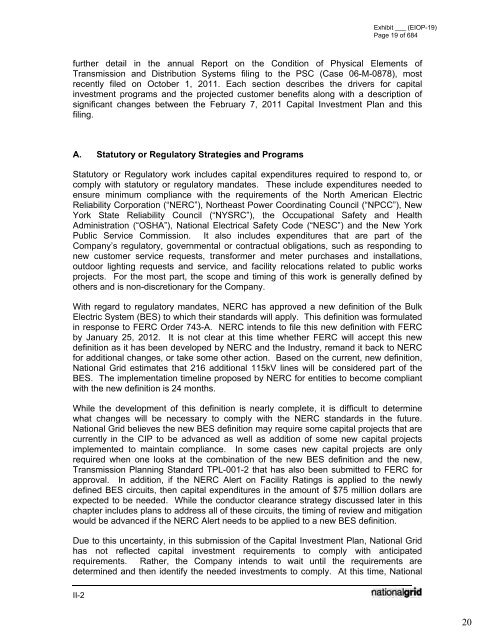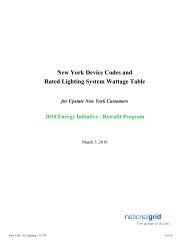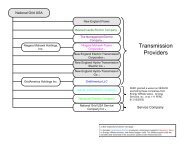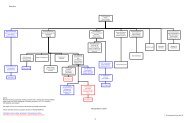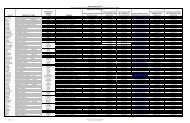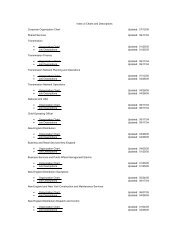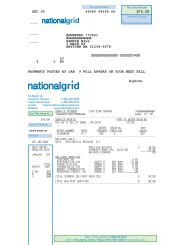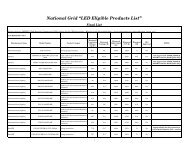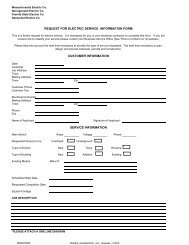January 2012 Capital Investment - National Grid
January 2012 Capital Investment - National Grid
January 2012 Capital Investment - National Grid
Create successful ePaper yourself
Turn your PDF publications into a flip-book with our unique Google optimized e-Paper software.
Exhibit ___ (EIOP-19)Page 19 of 684further detail in the annual Report on the Condition of Physical Elements ofTransmission and Distribution Systems filing to the PSC (Case 06-M-0878), mostrecently filed on October 1, 2011. Each section describes the drivers for capitalinvestment programs and the projected customer benefits along with a description ofsignificant changes between the February 7, 2011 <strong>Capital</strong> <strong>Investment</strong> Plan and thisfiling.A. Statutory or Regulatory Strategies and ProgramsStatutory or Regulatory work includes capital expenditures required to respond to, orcomply with statutory or regulatory mandates. These include expenditures needed toensure minimum compliance with the requirements of the North American ElectricReliability Corporation (“NERC”), Northeast Power Coordinating Council (“NPCC”), NewYork State Reliability Council (“NYSRC”), the Occupational Safety and HealthAdministration (“OSHA”), <strong>National</strong> Electrical Safety Code (“NESC”) and the New YorkPublic Service Commission. It also includes expenditures that are part of theCompany’s regulatory, governmental or contractual obligations, such as responding tonew customer service requests, transformer and meter purchases and installations,outdoor lighting requests and service, and facility relocations related to public worksprojects. For the most part, the scope and timing of this work is generally defined byothers and is non-discretionary for the Company.With regard to regulatory mandates, NERC has approved a new definition of the BulkElectric System (BES) to which their standards will apply. This definition was formulatedin response to FERC Order 743-A. NERC intends to file this new definition with FERCby <strong>January</strong> 25, <strong>2012</strong>. It is not clear at this time whether FERC will accept this newdefinition as it has been developed by NERC and the Industry, remand it back to NERCfor additional changes, or take some other action. Based on the current, new definition,<strong>National</strong> <strong>Grid</strong> estimates that 216 additional 115kV lines will be considered part of theBES. The implementation timeline proposed by NERC for entities to become compliantwith the new definition is 24 months.While the development of this definition is nearly complete, it is difficult to determinewhat changes will be necessary to comply with the NERC standards in the future.<strong>National</strong> <strong>Grid</strong> believes the new BES definition may require some capital projects that arecurrently in the CIP to be advanced as well as addition of some new capital projectsimplemented to maintain compliance. In some cases new capital projects are onlyrequired when one looks at the combination of the new BES definition and the new,Transmission Planning Standard TPL-001-2 that has also been submitted to FERC forapproval. In addition, if the NERC Alert on Facility Ratings is applied to the newlydefined BES circuits, then capital expenditures in the amount of $75 million dollars areexpected to be needed. While the conductor clearance strategy discussed later in thischapter includes plans to address all of these circuits, the timing of review and mitigationwould be advanced if the NERC Alert needs to be applied to a new BES definition.Due to this uncertainty, in this submission of the <strong>Capital</strong> <strong>Investment</strong> Plan, <strong>National</strong> <strong>Grid</strong>has not reflected capital investment requirements to comply with anticipatedrequirements. Rather, the Company intends to wait until the requirements aredetermined and then identify the needed investments to comply. At this time, <strong>National</strong>II-220


